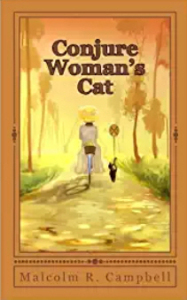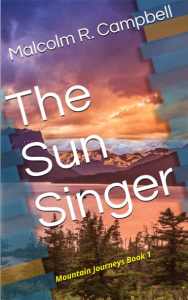Malcolm R. Campbell's Blog, page 73
July 9, 2021
Loving our parks to death
You’ve heard the old story, one version or another, about a family who builds a cabin next to a lake or on a high hill where there’s a spectacular view. Their friends visit, some build next door, then one day a restaurant appears and a gas station and a traffic light and a hotel and, in time, the place is just as crowded as the neighborhoods in town everyone tried to escape.
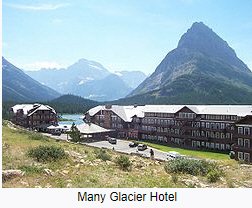 The national parks are suffering a similar death, one in which most people consider humans to be the most invasive species with the once pristine preserve. Years ago, Glacier National Park was considered the most threatened park in the NPS system, primarily from air and water polution that arose outside its borders. Now the new threat comes from within as the NPS continues to resist putting a cap on the number of visitors allowed each year.
The national parks are suffering a similar death, one in which most people consider humans to be the most invasive species with the once pristine preserve. Years ago, Glacier National Park was considered the most threatened park in the NPS system, primarily from air and water polution that arose outside its borders. Now the new threat comes from within as the NPS continues to resist putting a cap on the number of visitors allowed each year.
Glacier started a ticketed entry system this year. So far, it seems to be managing the traffic. The sad thing is this: it’s not reducing the traffic. A recent story said visitor counts on Sun Road in Glacier are up 41% over 2019. I had hoped the NPS would manage to reduce the number of visitors based on the premise that too many is too many if the park and its flora and fauna are to be preserved.
When a new building goes up in town, the fire marshal establishes a maximum occupancy in the name of safety. We need a similar limit for parks because once our invasive species of humans have overrun the place, it will lose everything the NPS was supposed to be preserving. In Glacier, there are traffic jams not only to get into the park, but of hikers waiting to use popular trails like the High Line which, I suppose, will one day have a turnstile at each end to control access.
Unfortunately, the most viable way to reduce visitor counts is also the most unfair: charging so much that people cannot afford the bill. This means the rich get in and the poor do not. The ticketed entry system seems to be helping at Glacier. I look forward, though, to the next viable and democratic system that truly keeps each year’s visitor counts to a safe level.
In the 1960s when I worked in Glacier as a seasonal employee, we said, “Thank goodness nodody knows where this place is.” Unfortunately, they’ve found out. The park was overcrowded several years ago: letting more people in is not the answer we need.
–Malcolm
Publisher: Thomas-Jacob Publishing
July 8, 2021
There’s a snake on the back porch
Our back deck has beeen screened in with a tight-fitting screen door. So how did the snake get in? We have no clue. From watching it off and on today, I’d say it also wondered how it got in because it appeared curious about how to get out.
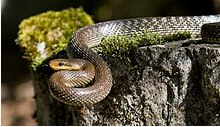 Hmmn, maybe yes, maybe no
Hmmn, maybe yes, maybe no
When people asked me for a description, I told them it was round, several feet long, and had a head on one end which appeared to be the front end. As for markings, they look like the kind of markings one would get if he got drunk at a tatoo shop that caters to Hell’s Angels.
In the old days, guys would throw a stick of dynamite out the door the porch and rebuild the deck later. So far, I’m not in that much of a rush. In fact, we may not need to go out there for the rest of the year. After all, we have multiple ways to get in and out of the house primarily in case this kind of thing happens.
I grew up in Florida where there were snakes, sting rays, and moray eels lurking about whenever one went on a camping trip or hung the clothes on the line to dry. We didn’t use the clothes line for a year when Mother decided there were pirana fish in the mud puddle that developed out there during a huricane. It was easier to just take her word for it rather than reach into the puddle to see what happened.
I went on line to see what kinds of snakes look like copperheads. There’s a fair number of them including the copperhead itself. But then, maybe it’s just a black racer or a ratsnake. We live in a rural area where there are a hundred mice per square foot, so snakes probably think we’re running a smorgaboard.
As far as I know, Amazon sells mongooses, so if the who shebang with the snake drags on, perhaps I’ll send off for a box. They aren’t as noisy as dynamite.
–Malcolm
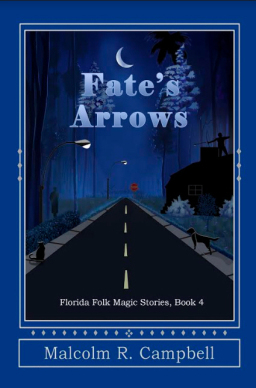 Malcolm R. Campbell is the author of magical realism books set in the Florida Panhandle.
Malcolm R. Campbell is the author of magical realism books set in the Florida Panhandle.
July 6, 2021
A cool selection of fiction
Child of Sorrow by Melinda Clayton
 When fourteen-year-old foster child Johnathan Thomas Woods is suspected of murder, an old letter and a tacky billboard advertisement lead him to the office of attorney Brian Stone. Recognizing the sense of hopelessness lurking under John’s angry façade, Stone is soon convinced of his innocence. When John offers up his lawn-mowing money as payment, Stone realizes this is a case he can’t refuse.
When fourteen-year-old foster child Johnathan Thomas Woods is suspected of murder, an old letter and a tacky billboard advertisement lead him to the office of attorney Brian Stone. Recognizing the sense of hopelessness lurking under John’s angry façade, Stone is soon convinced of his innocence. When John offers up his lawn-mowing money as payment, Stone realizes this is a case he can’t refuse.
In the face of overwhelming evidence assembled by the prosecution, Stone and his team find themselves in a race against time to save an angry boy who’s experienced more than his fair share of betrayal, a boy who more often than not doesn’t seem interested in saving himself.
–
An Inchworm Takes Wing by Robert Hays
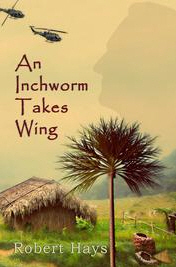 In the tranquil solitude of a darkened Room 12 in the ICU on the sixth floor of Memorial Hospital’s Wing C, a mortal existence is drawing to an end. His head and torso swathed in bandages, his arms and legs awkwardly positioned in hard casts and layers of heavy gauze, he’s surrounded by loved ones yet unable to communicate, isolated within his own thoughts and memories.
In the tranquil solitude of a darkened Room 12 in the ICU on the sixth floor of Memorial Hospital’s Wing C, a mortal existence is drawing to an end. His head and torso swathed in bandages, his arms and legs awkwardly positioned in hard casts and layers of heavy gauze, he’s surrounded by loved ones yet unable to communicate, isolated within his own thoughts and memories.
He does not believe himself to be an extraordinary man, simply an ordinary one, a man who’s made choices, both good and bad. A man who was sometimes selfish, sometimes misguided, sometimes kind and wise. A man who fought in a war in which he lost a part of his soul, who then became a teacher and worked hard to repair the damage.
When faced with the end, how does one reconcile the pieces of an ordinary life? Does a man have the right to wish for wings to carry him to a summit he believes he doesn’t deserve to reach?
–
Chasing Eve by Sharon Heath
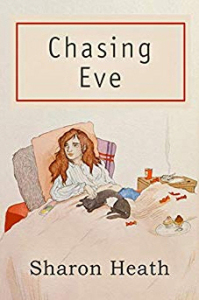 Everyone expected big things from Ariel Thompkins. Wasn’t she the girl who’d roped her friends into one madcap adventure after another, who’d met the challenge of losing both parents before turning eighteen, who’d gone on to graduate summa cum laude from UCLA? So how did this livewire end up delivering the day’s mail for the U.S. Postal Service, hunkering down each night with her half-blind cat in front of the TV, ruminating over the width of her thighs? It looked as though it would take a miracle to get her out of her rut. Who knew that miracle would come in the form of an acutely candid best friend and a motley crew of strangers—a homeless drunk once aptly nicknamed “Nosy,” a lonely old woman seeing catastrophe around every corner, a shy teenager fleeing sexual abuse, a handsome young transplant from the Midwest with a passion for acting and for Ariel herself? Not to mention the fossil remains of a flat-faced crone who just might have been the ancestress of everyone alive today? Chasing Eve takes us on a funny, sad, hair-raising adventure into the underbelly of the City of Angels, where society’s invisible people make a difference to themselves and to others, and where love sometimes actually saves the day.
Everyone expected big things from Ariel Thompkins. Wasn’t she the girl who’d roped her friends into one madcap adventure after another, who’d met the challenge of losing both parents before turning eighteen, who’d gone on to graduate summa cum laude from UCLA? So how did this livewire end up delivering the day’s mail for the U.S. Postal Service, hunkering down each night with her half-blind cat in front of the TV, ruminating over the width of her thighs? It looked as though it would take a miracle to get her out of her rut. Who knew that miracle would come in the form of an acutely candid best friend and a motley crew of strangers—a homeless drunk once aptly nicknamed “Nosy,” a lonely old woman seeing catastrophe around every corner, a shy teenager fleeing sexual abuse, a handsome young transplant from the Midwest with a passion for acting and for Ariel herself? Not to mention the fossil remains of a flat-faced crone who just might have been the ancestress of everyone alive today? Chasing Eve takes us on a funny, sad, hair-raising adventure into the underbelly of the City of Angels, where society’s invisible people make a difference to themselves and to others, and where love sometimes actually saves the day.
–
Who’s Munching by Milkweed? by Smoky Zeidel
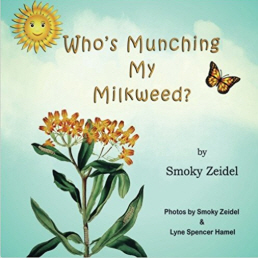 When Ms. Gardener discovers something has been munching on her milkweed plants, she embarks on a fun and educational monarch butterfly journey that enchants both children and adults.
When Ms. Gardener discovers something has been munching on her milkweed plants, she embarks on a fun and educational monarch butterfly journey that enchants both children and adults.
With Photographs. Zeidel is a Master Gardener.
July 5, 2021
Pack mule, old accident story
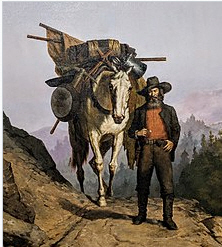 Yeah, I know, that’s not a mule.
Yeah, I know, that’s not a mule.If you hike enough trails in Glacier National Park, you’ll sooner oer later come along a pack train of mules hauling supplies to backcountry chalets, fire towers, and ranger stations. If I’d worked on one of those instead of as a bellman, I wouldn’t be spending all this time looking at YouTube videos about how to pack a mule and how to harness a mule.
Why do I care? One of the characters in my novel in progress hauls goods around the area in a mule train. So now I need to learn how he handles the mules and the tack. If I were in the Matrix movie, I could just download all that info into my brain and be an expert.
This is the kind of detail that really slows down the writing.
Old Accident
 Here’s a two-door version.
Here’s a two-door version.When we lived in Eugene, Oregon during the time I would have been in kindergarten, we seemed to have family and friends throughout Washington, Oregon, and California. So, we were on the road a lot in our giant, four-door 1950 Nash 600.
On one of those trips, we were passing a flatbed truck. Mother was driving, Dad was riding showgun, and my younger brothers and I were in the back seat. In those days, it seemed to be customary to tap the horn twice before passing somebody. Mother did that and then started doing around the truck when it swerved into our lane to pass a smaller car in front of him. Mother honked again and put on the brakes.
The truck driver saw us, over-corrected, and went rolling down through a field. I have know idea who called the police, but we were parked off on the shoulder for ages. After the officers figured out what happened, filled out their paperwork, we were allowed to go on.
The odd thing about this is that after it happened, my folks never spoke of it. Growing up, I didn’t think of it often, so never asked for details. The subject just never came up, and if there were injuries or fatalities in the truck (which seemed certain to me), I can see why my parents wouldn’t want to speak of it. Otherwise, I have no idea why–at least when I ws an adult–I never asked, “What do we know about the near collision with the truck when I was five?”
I’ve been searching digitized newspapers, but so far haven’t found anything. It would help if I knew for sure which state we were in when it happened. In an Internet age when we seem to hear about everything, most of which isn’t important, it’s frustrating to look back in time and find nada, zip, and endless void.
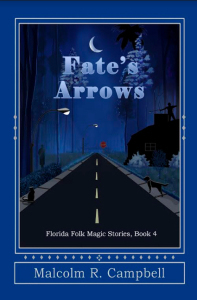 Malcolm R. Campbell is the author of Fate’s Arrows, available in e-book, audiobook, paperback and hard cover editions.
Malcolm R. Campbell is the author of Fate’s Arrows, available in e-book, audiobook, paperback and hard cover editions.
July 3, 2021
Briefly Noted: ‘Waltzing Montana’
 Mary Clearman Blew grew up on a small cattle ranch in Montana, on the site of her great-grandfather’s 1882 homestead. Her memoir “All But the Waltz: Essays on a Montana Family,” won a Pacific Northwest Booksellers Award, as did her short story collection, “Runaway.” – Author’s Website
Mary Clearman Blew grew up on a small cattle ranch in Montana, on the site of her great-grandfather’s 1882 homestead. Her memoir “All But the Waltz: Essays on a Montana Family,” won a Pacific Northwest Booksellers Award, as did her short story collection, “Runaway.” – Author’s Website
A refreshing and original story by an author who knews the territory. Blew is a writing professor at the Univerfsity of Idaho.
From the Publisher:
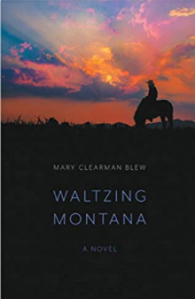 Midwife Mildred Harrington is riding back home one evening after checking on one of her pregnant neighbors when she stumbles upon an injured stranger. She soon realizes it’s her old sweetheart, Pat, from country school—and he may not be telling the full truth about how he was injured.
Midwife Mildred Harrington is riding back home one evening after checking on one of her pregnant neighbors when she stumbles upon an injured stranger. She soon realizes it’s her old sweetheart, Pat, from country school—and he may not be telling the full truth about how he was injured.
Set in rural Montana in 1925, Waltzing Montana follows Mildred as she grapples with feelings for Pat while also trying to overcome the horrific abuse she suffered as a young teenager. Ultimately Mildred must decide whether to continue her isolated life or accept the hand extended to her.
Inspired by the life of midwife Edna McGuire (1885–1969), who operated a sheep ranch in central Montana, Blew has turned the classic Western on its head, focusing on rural women and the gender and diversity challenges they faced during the 1920s.
Editorial Review:
“What we need most right now are stories that are down-to-the-bone authentic, and Mary Clearman Blew gives us one with her new novel, Waltzing Montana. The women and men in this book are not only resilient but find their true meaning in forging through challenge: drought, war, and the Spanish flu pandemic. And yet Blew artfully nods to their limits too. There’s only so much brutality a person can endure, and the ravages of pain and abandonment Blew portrays in these pages stir acts of forgiveness, patience, and abiding friendship, which allow the deepest wounds to finally heal.”—Debra Gwartney, author of I Am a Stranger Here Myself
–
The book has an apt and lovely cover; my only concern here is that the title and author’s name need to be more visible.
–Malcolm
Publisher: Thomas-Jacob Publishing
Available on Nook from B&N
July 2, 2021
Grand Teton National Park
The most famous photograph of Grand Teton National Park was taken by Ansel Adams in 1942 showing the Snake River in the foreground.

Many photographers take pictures of the Tetons from this side of the mountains.
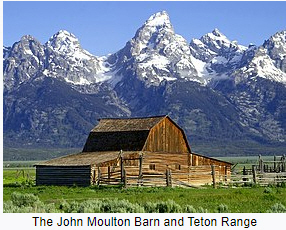 These days they’re usually in color and often show The John Moulton Barn. I see this view almost weekly on Facebook. If I hadn’t seen various sections of the Snake River when I was young, I’d be tempted to ask: “Is there another side to these mountains and, if so, why don’t we ever see it?”
These days they’re usually in color and often show The John Moulton Barn. I see this view almost weekly on Facebook. If I hadn’t seen various sections of the Snake River when I was young, I’d be tempted to ask: “Is there another side to these mountains and, if so, why don’t we ever see it?”
If I were a fan of conspiracy theories, I might ask for proof that these mountains are more than a giant mural or, perhaps, an exciting arête that’s no wider than a few hundred feet or so.
People have been visiting the Tetons as a 480-square mile National Park since 1929. According to the National Park Service, “Grand Teton National Park took decades to establish. Congress created the original park in 1929 to protect the Teton Range and several lakes at the foot of the mountains. In 1943, Franklin D. Roosevelt declared additional land in the valley to be Jackson Hole National Monument. In 1949, John D. Rockefeller, Jr. donated the land he purchased to the government to be included in the national park. Finally, in 1950, Congress combined the original park, the national monument, and the Rockefeller lands to establish the present-day Grand Teton National Park. In 1972, Congress established the John D. Rockefeller, Jr. Memorial Parkway, which connects Yellowstone and Grand Teton, to honor Rockefeller’s philanthropy and commitment to the National Park System.”
Sad to say, I have never been to Jackson Hole or climbed these mountains. Out of youthful stupidity, I skipped an opportunity to attend a photography class led by Ansel Adams in the 1960s because I was in love with somebody who finally ran off and married somebody else. If I had it to do over again, I would choose a more lasting experience. I might not be a professional photographer, but I would have met the master of western photography and (possibly) learned a few tips. Adams’ distinct style remains my favorite view of the out of doors.
And then perhaps my own camera would have proven to me that the Grand Tetons can be seen from both sides, like clouds.
–Malcolm
Publisher: Thomas-Jacob Publishing
July 1, 2021
Nightbeat: Why Book Sales Are Down
Nightbeat column, Star-Gazer News Service, Junction City, TX, July 1, 2021–Woke up early this morning because the “patriots” across the street were firing off cherry bombs and M-80s before the dawn’s early light even had a chance to pull itself together.
When I called the cops, the 911 dispatcher said they thought all that racket was “simply another neighborhood gang war, so hadn’t bothered to investigate.” I made coffee and checked to see if my typewriter had finished the column I started last night. Unfortunately, the only words on the otherwise blank sheet of Eaton’s Corrasable Bond typewriter paper was the title:
Nightbeat: Why Book Sales Are Down Sometimes evil spirits, haints, and things that go bump in the night write my columns while I’m sleeping or passed out. No luck, so I showered, shaved, drank two cups of Maxwell House Coffee, and walked to the bad part of the neighborhood which, actually, is right next door. I cut through the unmowed backyards so the “patriots” wouldn’t see me and knocked on the man’s back door.
Sometimes evil spirits, haints, and things that go bump in the night write my columns while I’m sleeping or passed out. No luck, so I showered, shaved, drank two cups of Maxwell House Coffee, and walked to the bad part of the neighborhood which, actually, is right next door. I cut through the unmowed backyards so the “patriots” wouldn’t see me and knocked on the man’s back door.
“Who sent you?” he asked.
“Bob Costas,” I whispered.
The door openly quickly and a withered arm snaked out and yanked me into the mudroom which, coincidentally, was filled with mud.
My source looked like death warmed over. “What do you need?”
“The straight skinny about falling book sales,” I said.
“Did James Patterson die last night?”
“No, but that wouldn’t matter since Tom Clancy is still churning out bestsellers.”
“When you’re right, you’re right, Jock,” he said as he lit up a Lucky Strike. “Otherwise, serious small press authors are being hurt because everyone thinks they have a book in them–actually, many books.”
“The old gag was ‘every journalist thinks he has a book in him and that’s where it should stay,'” I replied.
“My sources tell me the old rules and the old morals no longer count. Today’s self-published and small-press authors have developed writer’s diarrhea.”
“That stinks.”
“No sh_t. They’re–how should I put this?–spewing out cookie-cutter genre books at the rate of thousands of words per day per person. It’s the chief cause of global warming and insanity. I checked a secret survey last week and, as it turns out, only two or three people in the country are not writing books. You know what that means.”
He took a swig of Jack Daniels and passed me the bottle.
“Damn, that’s good,” I said. “Of course I know what it means. It means that Larry, Moe, and Curry, and the scum across the street are the only people out there who are still reading.”
“Damn straight.”
“So, that means that two or three people are using different names to post highly positive reviews on Amazon for those tawdry books while the good writers are lucky to find a review anywhere.”
“You planning to stay for breakfast.”
“Bacon and eggs?” I asked hopefully.
“Bangers and mash with gravy.”
“I’ll pass.”
“As always, this conversation never happened.”
“I know.”
I went home, typed up my notes, and faxed this column to the newspaper. The editor wouldn’t like it, but I don’t give a flaming rat’s butt about that because she knows I know she’s one of the people ruining literature with her 40-book series “The Piper and the Piper’s Missus.” People are addicted to it. It’s worse than Fentanyl.
Her readers are reviewing her books before they’re even released. We’re entering the end of times, kind readers, and you read it here first.
—Story filed by Jock Stewart, Special Investigative Reporter
June 30, 2021
Uncreative cook always needs recipes.
 If Chef Gordon Ramsay asked me as a contestant on “Hell’s Kitchen” or “MasterChef” to prepare my signature dish, I’d prepare a medium-well steak, with a baked potato wrapped in tin foil. If you watch either of these shows, you know (a) that Ramsay expects all steaks to be medium rare (i.e. raw), and (b) doesn’t believe in the concept of an entre with sides but one cohesive dish.
If Chef Gordon Ramsay asked me as a contestant on “Hell’s Kitchen” or “MasterChef” to prepare my signature dish, I’d prepare a medium-well steak, with a baked potato wrapped in tin foil. If you watch either of these shows, you know (a) that Ramsay expects all steaks to be medium rare (i.e. raw), and (b) doesn’t believe in the concept of an entre with sides but one cohesive dish.
Frankly, I don’t like raw steak or the one-dish concept where my steak is sitting on top of asparagus with a warm salad draped over the whole shebang.
 If you present an entre on “Chopped” with separate side dishes, the judges say, the flavors are here, but it’s not a cohesive dish.
If you present an entre on “Chopped” with separate side dishes, the judges say, the flavors are here, but it’s not a cohesive dish.
Best I can tell, Gordon, the judges on “MasterChef,” and “Chopped” all know how to cook. But, it’s fru-fru, Michelin Star cooking with all the food jumbled together on the plate with some puree or other used to decorate the empty space where the sides would normally go.
But, I digress. I do most of the grocery shopping and cooking in our house and my wife does most of the laundry. I have the cookbooks I grew up with. Gordon would hate them. So that’s where I go for ideas. Like pot roast: there’s something you don’t see on “MasterChef” even though it’s certainly cohesive except not with a Waldorf salad perched on top of it.
We’re having barbecued pork on sesame seed buns for supper. The recipe came with the cookbook included with our Rival Crockpot ten years ago. The judges on “Chopped” love it when contestants say they learned to cook from their mothers’ expertise in the kitchen. I doubt they’d react with the same tearful “Aw, ain’t that wonderful” kind of comment if I said I was inspired by a cookbook from a slow cooker manufacturer.
My mother and my wife’s mother both cooked the way people were taught in the 1950s either via home economics or their own mothers. That’s still our foundation. And it really tends to make me suspect the foundation of all the beautiful people (dressed to the nines) who show up for a meal on “Hell’s Kitchen.”
I don’t think I want to know any of those people. They’re eating really weird stuff that would cause you to be shot if you asked for it at a Cracker Barrel. As I type this post, my Rival Crockpot meal is cooking in my Rival Crockpot. Put that in your pipe and smoke it, Chef Ramsay.
–Malcolm
Publisher: Thomas-Jacob Publishing
June 29, 2021
Briefly noted: ‘A Search for Safe Passage’
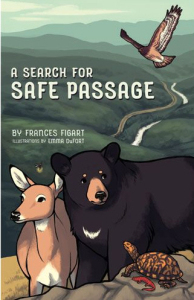 Available from the association’s online shop.
Available from the association’s online shop.
When I saw a story about this book and the related efforts near the Great Smoky Mountain’s National Park in the summer 2021 issue of “National Parks Magazine,” I had to share it here. The author, Frances Figart, is the creative services director of the Great Smoky Mountains Association. Her book, as the article says, “is part of an effort to raise awareness about the real-life situation along Interstate 40, a four-lane road that runs through the Pigeon River Gorge” near the park.
I know the road well, but it’s not a friend of the wildlife that find it to be either a fence or a death trap to their natural migrations through the area. A coalition of groups is looking for solutions, including animal overpasses and tunnels.
From the Publisher“A Search for Safe Passage” tells the story of best friends Bear and Deer who grew up together on the North side of a beautiful Appalachian gorge. In the time of their grandparents, animals could travel freely on either side of a fast-flowing river, but now the dangerous Human Highway divides their home range into the North and South sides. On the night of a full moon, two strangers arrive from the South with news that will lead to tough decisions, a life-changing adventure, and new friends joining in a search for safe passage. The book is closely connected to Safe Passage: The I-40 Pigeon River Gorge Wildlife Crossing Project, a new public education and infrastructure development campaign in Western North Carolina and East Tennessee. It includes an additional nonfiction section with educational lessons about animal habitat requirements, behavior, migration patterns, and roadway ecology problems and solutions developed with input from both international and local experts. Aimed at readers ages 7 to 13. 122 pages, 5.5″ x 8.5″.
Beautifully illustrated by Emma DuFort, the book presents a compelling story that should help make young people aware of oversights (being corrected in many areas) of the federal highway system when it comes to the animal populations who live where humans want to drive cars and trucks.
–Malcolm
June 28, 2021
Mountains. . .before I got too old to climb them
Now as I was young and easy under the apple boughs
About the lilting house and happy as the grass was green,
The night above the dingle starry,
Time let me hail and climb
Golden in the heydays of his eyes. . .
from “Fern Hill” by Dylan Thomas
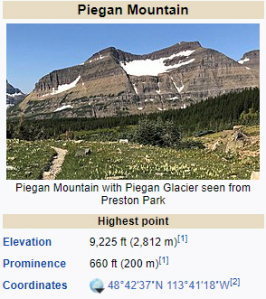 When I first explored the mountains of Glacier National Park, “time let me hail and climb golden in the heydays of his eyes.” I thought those trails and those days would go on forever even though I had read the Dylan Thomas poem many times and knew how it ended. Even though grandparents are around us when we are young, we still think we will always be young and, that if we won’t, old age is eons away in a future too far away to fathom.
When I first explored the mountains of Glacier National Park, “time let me hail and climb golden in the heydays of his eyes.” I thought those trails and those days would go on forever even though I had read the Dylan Thomas poem many times and knew how it ended. Even though grandparents are around us when we are young, we still think we will always be young and, that if we won’t, old age is eons away in a future too far away to fathom.
When we’re young, it’s hard to imagine being old. When we’re old, it’s easy to remember being young just as I remember the first time I read “Fern Hill” and was concerned about the words: “ In the sun that is young once only, time let me play and be golden in the mercy of his means.”
As I write a novel now about a character following a trail near Piegan Mountain, I must rely on the videos and descriptions of younger men and women, those who are still healthy in time’s golden era. If I’d only known, some 50 years ago, that I’d be writing this novel, I would have taken a hundred photographs along the trail that led from Going to Sun Road to Many Glacier Hotel. But I was too enchanted within the moment to create a photographic diary on Ektachrome film. (Regrets, I’ve had a few.)
If there’s a learning experience in all this, it’s to push on with the writing using the resources I can find rather than wishing (a) I could be young again, (b) took 1000 photographs of everything, and (c) ruined my life experiences by slavishly documenting them for those old-age years when they would be beyond reach.
When we have finally followed time out of grace, our memories must suffice, all the more sweet because they are so tangled and unclear rather like a dream of once walking the high country when knees and ankles and breath were strong and the sky was blue and full of endless promise from side to side.
–Malcolm
Malcolm R. Campbell
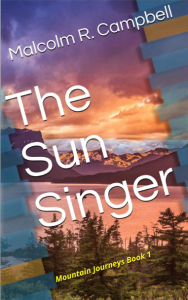 Publisher: Thomas-Jacob Publishing
Publisher: Thomas-Jacob Publishing


